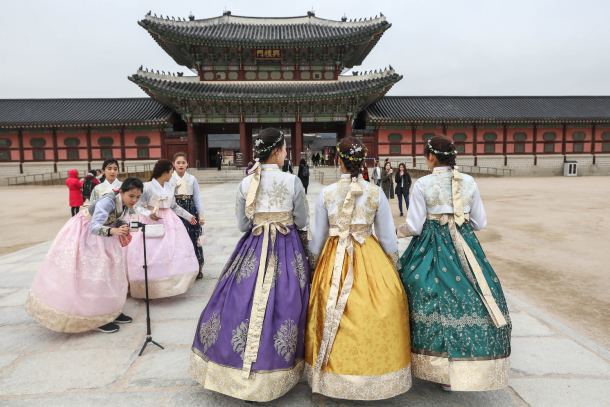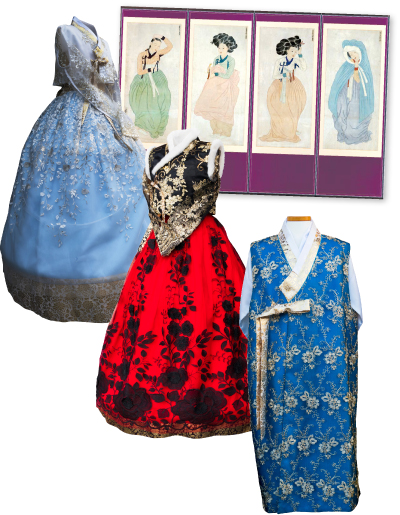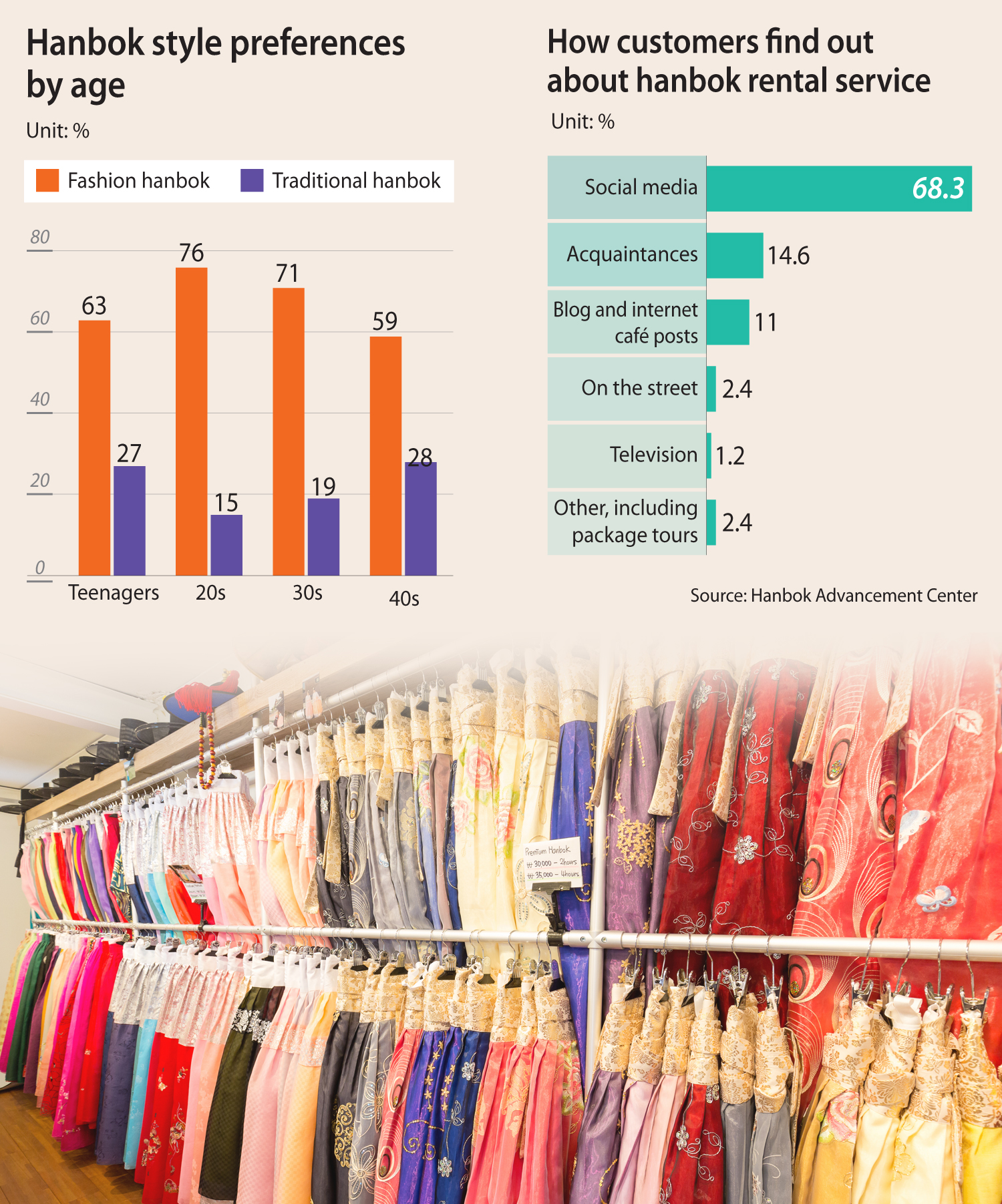Has hanbok strayed too far from tradition?: Some worry Korea’s iconic dress has lost its way in recent years

Above, weekend visitors to Gyeongbok Palace in central Seoul wear fashion hanbok rented from shops nearby. Although the dresses look pretty, they are quite different from the conventional form of the traditional attire, as can be seen in examples of popular hanbok these days, below left. Paintings by Chae Yong-shin (1850-1941), below right, depict women from the Joseon era (1392-1910). [NEWS1, SHUTTERSTOCK]
Hoping to make the traditional garment more a part of people’s lives, the government and experts in related fields have been trying to encourage people to wear hanbok, or at least variations of the dress that embody a hint of the traditional attire. Their efforts involved a series of events ranging from declared hanbok-wearing days and holding hanbok festivals and giving discounts to the country’s royal palace to people wearing hanbok. Thanks to their efforts, wearing hanbok has become more familiar to the general public compared to a decade ago.
The biggest problem in traditional clothing today actually stems from the efforts of trying to increase the number of people wearing hanbok, regardless of the style. While at first it was important to get people to try hanbok, the variety of styles that have been created now have some wondering if there are rules for what constitutes a proper hanbok.
As more people take to the streets wearing forms of hanbok that have never been seen before, two perspectives have come into conflict. On one hand, some advocate that hanbok should adhere to the traditional form of the dress, while the other side believes that it’s meaningful in itself that more people are wearing hanbok, even if it is somewhat distanced from the conventional form.

On the weekends, the streets around the royal palaces in central Seoul - Gyeongbok Palace, Changdeok Palace and Deoksu Palace - are filled with visitors wearing hanbok they borrowed from hanbok rental shops nearby at prices usually ranging from 15,000 ($13.30) to 20,000 won. Wearing all colors and styles of hanbok, young people in their teens and 20s and groups of foreign tourists try to find the best spot to take pictures among the historical buildings.
“This kind of hanbok with fancy colors and modernized designs seems more suitable for modern people like us,” said a tourist from Hong Kong, who visited Korea this summer with a group of female friends, who were also all happily dressed up in what they called modern hanbok. Holding hands and walking down the street in Samcheong-dong, central Seoul, they all agreed that the hanbok they rented is much more convenient to walk around in than the actual traditional dress worn long ago.
What’s most noticeable about their outfits is that while they are obviously wearing hanbok, a closer look may make some second guess their authenticity. The jeogori, the upper garment, and the skirt are accented with lace, the sleeves are sometimes see-through, and the accessories in the women’s hair are crowns of flowers and butterflies in addition to the daenggi, a traditional women’s hair ornament. There were also large ribbons attached to the back of each of the women’s dresses.
These new forms of hanbok are referred to as “fusion hanbok” in Korea, and give off a different ambience than the “modernized hanbok” from the 1950s or the “life hanbok” designed in the 1980s.
The two terms are still used frequently to refer to the various types of the traditional attire, but a proper usage travels back to the earlier part of the 20th century when Korean people saw the need for hanbok to return after it was banned in the peninsula during Japanese Colonial Rule (1910-1945). In an effort to revive the forgotten culture in a post-war era, the new dress was simple both in form and color, with no extra decorations.
Life hanbok, on the other hand, was created in the 1980s by activist university students who sought to inherit the spirit of Korean history and add fashionable elements so that hanbok could be worn by people on a daily basis. Different colors were used, as well as more extravagant materials to meet different tastes.
Contemporary hanbok also shares the goal of keeping the tradition without looking traditional. Among the many young people wearing hanbok on the weekends, a great majority wear loudly decorated dresses that look as if they have all come from the same shops.
Regardless of the style, anyone wearing hanbok can get free entrance into the royal palaces, a policy that was enacted in 2015. The current guideline provided by the Cultural Heritage Association does not distinguish between traditional hanbok or fashion hanbok, so anyone wearing anything that remotely resembles hanbok can get in for free. That was, until now.

Earlier this month, the Jongno District Office requested the country’s Cultural Heritage Administration allow only those wearing traditional hanbok to visit palaces for free. The district government argued that people wearing fashion hanbok are “distorting the tradition.” Although their request didn’t mean that anyone would be banning fashion hanbok, a strong message was sent to rental shop owners and younger consumers. The district government will also be taking away the 10 percent discounts it gave to people wearing hanbok in certain hansik (Korean food) restaurants.
On Sept. 11, the Jongno government held an open forum on the subject of “Wearing Our Dress Right.” Around 150 people attended the debate including officials from the Cultural Heritage Association, the Ministry of Culture, Sports and Tourism, rental shop owners, hanbok designers and related experts.
Although the forum did not come to a single decision at the end, it was the first time that officials and civilians were able to come together and share their thoughts on just where this ship is sailing. Jongno District Office head Kim Young-jong opened up the forum with a welcoming speech, in which he expressed his desire to preserve the traditional dress as close to its original form as people could. If it strays too much from what we know, then is it valid to call it tradition, wondered Kim.
“It’s a good sign that more people are wearing hanbok as a means of fashion,” said Kim. “But I am concerned that the distorted forms of hanbok that are made in other countries, like Vietnam and China, are being called reformed versions of hanbok. But they are not. They are not ours. Reformation is good, but traditions are supposed to be kept, which is why we are in need of a discussion.”
“More and more people are visiting the royal palaces wearing something that’s hard to call Korean traditional clothing. They don’t look pretty, and I’m rather worried that our traditional hanbok is losing its place in the society,” added Professor Keum Jong-suk from the Korea National University of Cultural Heritage.
However, some people, mostly rental shop owners and those working with the younger generation, believe that the advent of the fashion hanbok is just a beginning of a new culture in which wearing hanbok becomes a way for people to explore traditions in a playful and fun manner.
“I have been running a hanbok rental shop for three years, even before the influx of rental shops near Gyeongbok Palace,” said Hwang Sang-jung, owner of Choyeon Hanbok rental shop. “The fashion hanbok came about two years ago, which is very popular among younger customers. Looking back, that was when the modernized versions of hanbok started to lose their appeal. I hope that people don’t look at this as a matter of right and wrong. It’s an issue where everyone needs to accept differences.”
A question mark
As meaningful as the forum was, no definitive conclusion came from any party. According to an official from the Cultural Heritage Association, creating a single and clear-cut guideline is much easier said than done. Though the official said that the foundation will be looking closely into the matter of palace entrance discounts, they stressed that guidelines need to be discussed.
“Even now, the existing guideline defines all hanbok as valid,” said the official. “But if we are going to pin down something as traditional, first we’re going to have to decide on just which period we’re going to call traditional. If we’re going to go with the Joseon Dynasty, for example, is it going to be early Joseon? Mid-Joseon or late Joseon? And even if we do decide on a period, the shapes and styles vary for region and class. We just can’t define what traditional hanbok is.”
Though nothing was decided, it’s a step forward that communications have begun. Kwon Mi-ru, a hanbok-spreading activist, agrees that although people may differ on their beliefs regarding maintaining tradition, what’s essential is that we all keep the core of tradition in our hearts.
“If we can find the core, then it can work as a standard for everything else that we do. We have to put our hearts together in going in the right direction. We are all here because we love hanbok. And for us to find the right value, then we will be able to make it better.”
BY YOON SO-YEON [yoon.soyeon@joongang.co.kr]










with the Korea JoongAng Daily
To write comments, please log in to one of the accounts.
Standards Board Policy (0/250자)